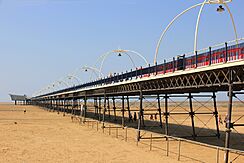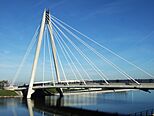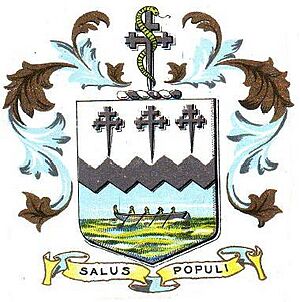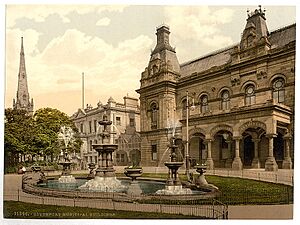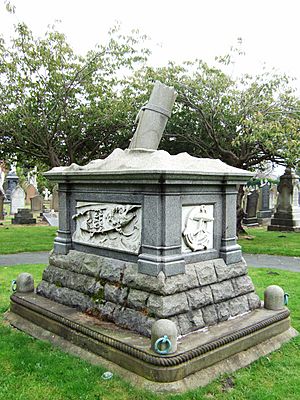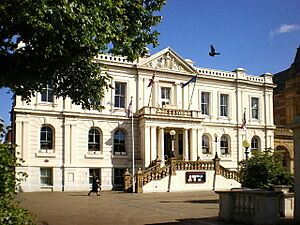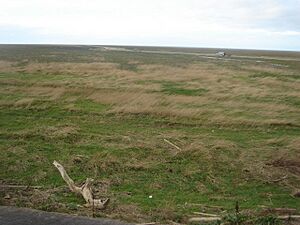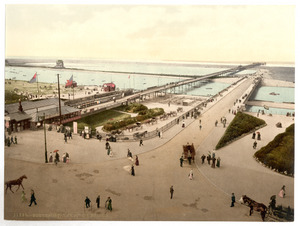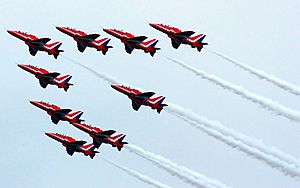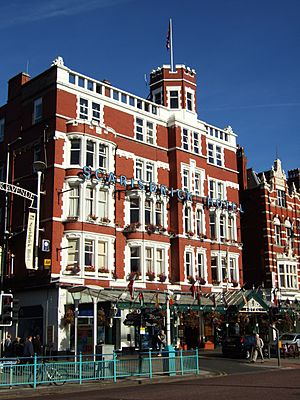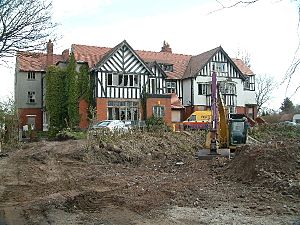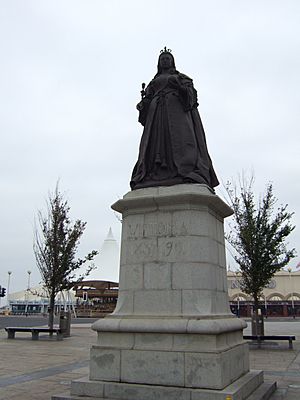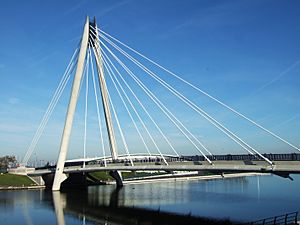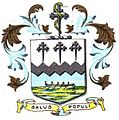Southport facts for kids
Quick facts for kids Southport |
|
|---|---|
| Town | |
|
|
|
| Population | 94,421 (2021 Census) |
| Demonym | Sandgrounder |
| OS grid reference | SD333170 |
| • London | 191 mi (307 km) SE |
| Metropolitan borough |
|
| Metropolitan county | |
| Region | |
| Country | England |
| Sovereign state | United Kingdom |
| Post town | Southport |
| Postcode district | PR8, PR9 |
| Dialling code | 01704 |
| Police | Merseyside |
| Fire | Merseyside |
| Ambulance | North West |
| EU Parliament | North West England |
| UK Parliament |
|
Southport is a fun seaside town in Merseyside, England. It sits on the West Lancashire coastal plain, right by the Irish Sea. Southport is about 17 miles (27 km) north of Liverpool. In 2021, about 94,421 people lived here. This makes it one of the biggest towns in North West England.
The town started in 1792. A man named William Sutton, who owned an inn, built a special bathing house. This was at the south end of what is now Lord Street. Before this, the area was mostly sand dunes. Southport became popular with visitors because it was easy to reach from the nearby Leeds and Liverpool Canal. By 1848, it even had a railway!
Southport grew a lot during the Victorian era. You can still see many beautiful Victorian buildings and streets. Lord Street became a wide, tree-lined shopping street. Famous places like Southport Pier were built. This pier is the second longest pleasure pier in the British Isles. The town is known for its many trees. This was a rule set by the Hesketh family, who owned the land. Hesketh Park is named after them.
Long sand dunes stretch for miles from Woodvale to Birkdale. The Ainsdale dunes are a special nature reserve. Here, you can find animals like the natterjack toad and the sand lizard. Southport also hosts exciting events. These include an annual air show and the UK's biggest independent flower show. The town is also famous for golf, with the Royal Birkdale Golf Club hosting major championships.
Contents
- What's in a Name?
- A Look Back in Time
- How Southport is Governed
- Where is Southport?
- Who Lives in Southport?
- Southport's Economy
- Fun Places to Visit
- Getting Around Southport
- Learning in Southport
- Southport in the Media
- Sports in Southport
- Famous People from Southport
- Famous Animals and More
- Images for kids
- See also
What's in a Name?
The town got its name from the South Port Hotel. This hotel was built around 1797.
A Look Back in Time
Early Settlements (10th–17th Century)
People have lived in the Southport area since the time of the Domesday Book. Some local names even come from the Vikings! The earliest people here were hunter-gatherers during the Middle Stone Age. They came for the animals and fish.
Later, the Domesday Book mentioned a settlement called Otergimele. It had about 50 huts and 200 people. A small group of people lived where the sand dunes met the river. This is where the village of Churchtown began. Its church, St Cuthbert's, is still there today.
The area grew with a busy fishing industry. Villages like South Hawes and Crossens became part of the North Meols parish. In 1692, a channel was dug to drain Martin Mere to the sea. This helped create good farmland, leading to a strong farming industry.
How Southport Began (18th Century)
In the late 1700s, it became popular for rich people to visit the seaside. Doctors thought sea bathing was good for health. In 1792, William Sutton, an inn owner from Churchtown, had an idea. He built a bathing house in the empty sand dunes at South Hawes. This spot was close to the new Leeds and Liverpool Canal.
In 1797, Sutton built a new inn on the site of his bathing house. He called it the South Port Hotel. Even though there was no actual port, the name "Southport" stuck! People thought Sutton was a bit crazy, calling his building the Duke's Folly. But Sutton arranged transport from the canal, and his hotel did very well. The original hotel was taken down in 1854. But a plaque, Duke Street, and the Dukes Folly Hotel still remember him.
Growing Up (19th Century)
Southport grew fast in the 1800s. It became known as a fancy seaside resort. It had an advantage because of its easy access to the canal system. By 1820, Southport had over 20,000 visitors each year.
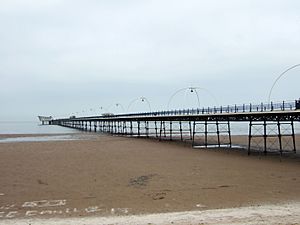
Southport Pier was one of the first "pleasure piers" made of iron. It cost £8,700 to build. The pier officially opened on August 2, 1860.
On December 9, 1886, a terrible lifeboat disaster happened off Southport's coast. A ship called the Mexico was in trouble. Lifeboats from Lytham, St. Annes, and Southport went to help. The crews faced a huge storm. Sadly, 28 lifeboatmen lost their lives that night. This left many families without fathers.
A memorial was put up in Duke Street Cemetery. There is also a display at The Atkinson museum. The Southport Offshore Rescue Trust lifeboat house has another memorial.
Modern Times (20th and 21st Centuries)
From 1894 to 1912, Birkdale and Ainsdale were separate. They joined Southport in 1912, making the town much bigger.
In 1925, the RNLI (Royal National Lifeboat Institution) closed its station in Southport. But in the late 1980s, local families raised money to buy a new lifeboat. This lifeboat is run by the Southport Offshore Rescue Trust. It relies on public donations.
On March 21, 1926, Henry Segrave set a new land speed record. He drove his Sunbeam Tiger car at 152.33 mph (245.15 km/h) on Southport's sands. This record lasted for over a month.
In 2024, Southport elected its first ever Labour Member of Parliament (MP).
How Southport is Governed
Southport is part of the Metropolitan Borough of Sefton. This is one of six boroughs in the Liverpool City Region. The Mayor of the Liverpool City Region and the combined authority help manage things like transport and trade.
Becoming Part of Merseyside
Southport used to be part of Lancashire. In 1971, there were plans to change how local areas were governed. Southport wanted to keep its own education and social services. So, it asked to join the new metropolitan county of Merseyside. It became part of the Metropolitan Borough of Sefton.
Some people in Southport want the town to leave Sefton and become its own area. They think Southport would do better on its own. This idea has been discussed for many years.
Where is Southport?
The closest big cities are Preston (20 km northeast) and Liverpool (27 km south).
Most of Southport is very close to sea level. Because of this, parts of the town used to flood. But new sea defences were built between 1997 and 2002. Now, the town is much safer from high tides.
Southport has a maritime climate, like most of the UK. It rarely gets much snow. Temperatures usually stay above -5°C, so there are not many frosts. Southport generally has moderate rain.
The Trans Pennine Trail starts in Southport. This path stretches 215 miles (346 km) across northern England. It's great for walkers, cyclists, and horse riders. It connects the North Sea and the Irish Sea.
 |
Irish Sea | Ribble Estuary, Blackpool | Banks, Preston |  |
| Irish Sea | Mere Brow, Holmeswood | |||
| Formby | Halsall, Shirdley Hill, Liverpool | Scarisbrick, Ormskirk |
Who Lives in Southport?
In 2001, Southport had 90,336 residents. About 96% of them were born in the UK.
Southport's population grew quickly during the Industrial Revolution. It has been quite stable since then.
| Population growth in Southport between 1901–2011 | ||||||||||||||||||||||||||||||||||||||
|---|---|---|---|---|---|---|---|---|---|---|---|---|---|---|---|---|---|---|---|---|---|---|---|---|---|---|---|---|---|---|---|---|---|---|---|---|---|---|
|
|
|
||||||||||||||||||||||||||||||||||||
| Source: Southport – A Vision of Britain, City Population – Southport & | ||||||||||||||||||||||||||||||||||||||
Southport's Economy
Tourism and Events
Southport has always been a popular place for holidays. It still relies on tourism today. When cheap flights became available in the 1960s, fewer people holidayed in the UK. But Southport adapted by hosting many events. In 2011, Southport was the 14th most popular coastal resort in the UK.
Some popular events include:
- Southport Airshow: A big air show held every summer.
- Southport Flower Show: The largest independent flower show in the UK.
- British Musical Fireworks Championships.
- Southport International Jazz Festival.
- Southport Food and Drink Festival.
- Southport 24 Hour Race: A tough sailing race where boats race for 24 hours straight.
Shopping and Business
Southport has many businesses, not just tourism. Lord Street is the main shopping street. It's famous for its tree-lined look, said to inspire the boulevards of Paris. Chapel Street is also a popular shopping area. Southport has an indoor market and a farmers' market.
The town also hosts conferences. The former Southport Theatre & Convention Centre is being replaced by a new Marine Lake Events Centre.
England's Golf Coast
Southport is known as England's Golfing Capital. It's home to Royal Birkdale Golf Club, which hosts the famous The Open Championship. Other golf courses include Southport Old Links, Hesketh Golf Club, Hillside Golf Club, and Southport and Ainsdale Golf Club.
Fun Places to Visit
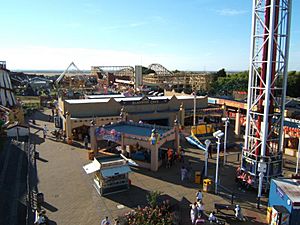
One of Southport's main attractions is Pleasureland, a funfair that opened in 1912. It closed in 2006 but a new version, New Pleasureland, opened in 2007.
The Southport Model Railway Village is a charming place with miniature trains and buildings. It opened in 1996 and is still run by the family who created it.
Other attractions include Splash World, an indoor water park. Meols Hall, a historic manor house, is open to the public at certain times. You can also visit the British Lawnmower Museum!
Amazing Buildings
Southport has many unique buildings. Many Victorian houses and town centre shops are very interesting to see.
Some notable places include:
- Lakeside Miniature Railway
- Southport Pier
- Marine Way Bridge
- Lord Street
- Southport Model Railway Village
- Smedley Hydro: A former health spa, now used by the Home Office.
- Botanic Gardens
- Hesketh Park
- Rosefield Hall: A grand house built in 1908.
- Meols Hall
- Wayfarers Arcade: A beautiful shopping arcade.
- The Atkinson: A museum and art gallery.
- St Cuthbert's Church
- St George's United Reformed Church, Lord Street
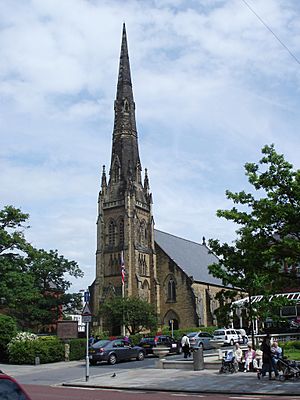
- Holy Trinity Church
- Queen Victoria Statue: A statue of the Queen on Nevill Street.
Statue of Queen Victoria on Nevill Street
- Garrick Theatre: A former theatre built in 1932.
Getting Around Southport
Road Travel
Southport is a coastal town, so roads mainly come from the south or east. The main roads are the A565 and A570. The nearest motorways are the M58, M57, and M6.
A big change to the roads was the Marine Way Bridge. It opened in 2004 and connects the shopping area to the seafront. This 150-foot (46 m) high bridge cost about £5 million. Chapel Street, a main shopping area, has also been made pedestrian-friendly.
Bus Services
Many bus services in Southport travel from south to north or east. The main bus company is Arriva North West. They run services to Liverpool, Wigan, and Skelmersdale. Stagecoach Merseyside & South Lancashire also runs services to Preston and Chorley.
Train Travel
Southport railway station has frequent trains to Liverpool, run by Merseyrail. There are also regular trains to Wigan, Bolton, Manchester, and Leeds. Other stations in Southport include Birkdale, Hillside, Ainsdale, and Meols Cop.
The first railway line to Southport opened in 1848. Over time, more lines were built, connecting Southport to many other towns.
On Southport Pier, there used to be the Southport Pier Tramway. It took passengers along the pier. It closed in 2016 because the trams were too heavy for the pier.
The Lakeside Miniature Railway runs under the pier. It carries passengers along the Marine Lake. It claims to be the oldest continuously running 15-inch gauge railway in the world.
Learning in Southport
Southport has several schools. Greenbank High School is an all-girls school. Its brother school is the all-boys Birkdale High School. Other high schools include Meols Cop High School, Stanley High School, and Christ the King High School. Famous people like comedian Lee Mack went to Stanley High School.
Colleges
The town has two colleges for further education. These are Southport College and King George V College (KGV). They offer different courses to help students prepare for jobs or university.
Southport in the Media
Newspapers
Southport has local newspapers like the free Champion and The Southport Visiter. The town is also covered by regional newspapers like The Liverpool Echo. There are also online news sites, including the Southport Reporter.
Radio and TV
Southport has its own local radio station, Mighty Radio. It broadcasts on 107.9 MHz FM and online. It shares local news and supports charities. Southport is also covered by bigger radio stations like Hits Radio Liverpool and BBC Radio Merseyside. For TV, Southport is in the regions of BBC North West and ITV's Granada Television.
Sports in Southport
Football
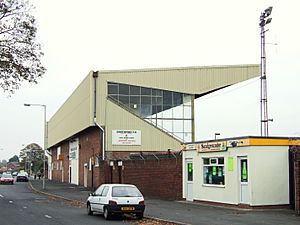
Southport is home to Southport F.C.. They have played at the Haig Avenue ground since 1905. The club joined The Football League in 1921. They are currently in the National League North, which is the sixth level of English football.
Rugby
Southport also has a rugby union club, Southport Rugby Football Club. They play their games at Waterloo Road. The club has teams for all ages. It was founded in 1872, making it one of the oldest rugby clubs in the world!
Golf
The Royal Birkdale Golf Club is a very famous golf course. It has hosted major championships like The Open Championship and the Ryder Cup. Other important golf clubs include Southport and Ainsdale Golf Club, Hillside Golf Club, and Hesketh Golf Club.
Kite Surfing

Ainsdale Beach, south of Southport, is a popular spot for kite sports, like kite-surfing.
Land Speed Record
In 1925, Henry Segrave set a world land speed record of 152.33 mph (245.15 km/h) on Southport beach. A pub on Lord Street is named after him.
Water Sports
Marine Lake is located between the town centre and the sea. It's used for water sports like water-skiing, sailing, and rowing. The West Lancs Yacht Club and Southport Sailing Club hold dinghy races here. The annual Southport 24 Hour Race is a famous endurance race.
Cycling
The flat path along the beach is great for cyclists. It's the start of the Trans Pennine Trail, a cycle route that goes all the way across northern England. In 2008, Southport was chosen as one of 11 new "cycling towns." This means more money is spent on making cycling easier and more fun in the town.
Famous People from Southport
- Ronnie Fearn, Baron Fearn (1931–2022), a politician who was an MP for Southport.
- Lee Mack, a well-known comedian and actor.
- Michael Rimmer, an 800-metre athlete.
- Marc Almond, a singer and songwriter from the band Soft Cell.
- William Rimmer, a composer and conductor.
- G. B. Samuelson, a pioneer in British cinema.
- Marcus Wareing, a famous chef.
Famous Animals and More
- Red Rum: A record-breaking racehorse who won the Aintree Grand National three times.
- Eagle: A popular comic for boys that started in Southport.
Images for kids
See also
 In Spanish: Southport para niños
In Spanish: Southport para niños


